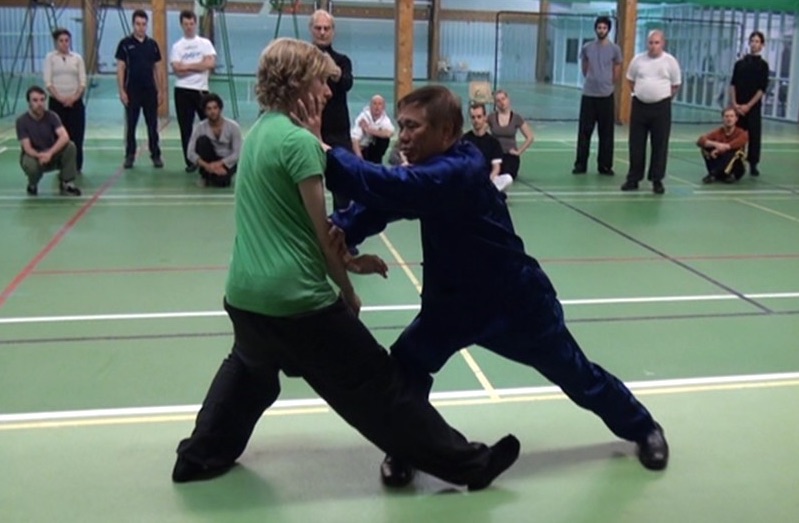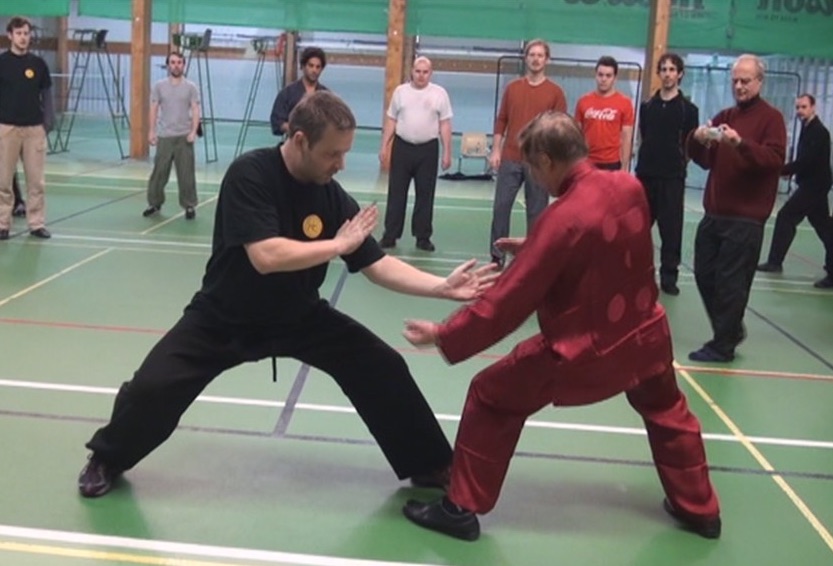ONE-FINGER ZEN, TIGER CLAW, OPEN PALM AND OTHER HAND FORMS IN ASKING BRIDGE

Using tiger-claws in Asking Bridge
Question
A Hoong Ka kwoon I've been training at places a heavy emphasis on Asking Bridge as a training tool for sensitivity and for developing skills to eventually use in free sparring. The sifu said that Asking Bridge was so important that in the past, Hoong Ka was called "Twelve Bridging Hands Kung Fu" in some circles. He said that the Bridge Hand (which resembles the One Finger Zen hand-form) is often used.
In documentaries and videos I have seen on YouTube, I see many Hoong Ka practitioners using the Bridge Hand in exercises which resemble Shaolin Wahnam's Asking Bridge.
Could Sigung talk about why the Bridge Hand/One Finger Zen hand-form is so useful (and hence popular) in Hoong Ka Kung Fu, in particular with sensitivity exercises such as Asking Bridge? Are other hand-forms particularly suitable or not suitable for Asking Bridge? I personally have good results with the thread-hand and open palms, but not with the Bridge Hand.
Fred Chu
Answer
Asking Bridge is important in Hoong Ka Kungfu, though many Hoong Ka schools today do not practice it. The hand-form usually used in Asking Bridge is the Tiger Claw or the One-Finger Zen hand form.
The main purpose of training Asking Bridge in Hoong Ka Kungfu is to develop internal force. This is in conjunction with training the Iron Wire set, which develops 12 different types of internal force. As I have mentioned elsewhere, it is actually the same type of internal force but used in 12 different ways which are collectively classified into two main groups of “hard” and “soft”, making 12 different categories of force in all.
Some Hoong Ka schools also use Asking Bridge to train sensitivity. This is wholesome, harmonizing yin-yang in their training. However, the kind of sensitivity in Hoong Ka Asking Bridge is unlike that in Taijiquan Pushing Hands or Wing Choon Sticking Hands. Hoong Ka sensitivity is “hard”, whereas that in Taijiquan and Wing Choon is “soft”.
The term “bridge hand”, or “kiew sau” in Chinese (Cantonese), refers to the forearm. This term is usually used in Hoong Ka Kungfu. It is often the part that maintains a bridge, or in contact, with an opponent. Irrespective of whether the hand is held in a One-finger Zen hand form, Tiger-Claw or any other hand form, the forearm is still referred to as the “bridge hand”.
The “bridge hand” or forearm is popular in all styles of kungfu, though in other styles other than Hoong Ka the term “bridge hand” is seldom used. This is because it is the part that is usually in contact with an opponent.
But how the “bridge hand” is used is different in different kungfu styles. In Hoong Ka it is often employed with force, pressing down an opponent’s arm to gain an upper position. In Wing Choon Kungfu, it is used to sense an opponent’s movement. In Taijiquan it is used to maneuver an opponent so as to gain a technical or a tactical advantage. In Wuzuquan it is used to control an opponent. In Shaolin Wahnam, because of our breadth and depth, we use it for all these benefits.
Using the “bridge hand” with the One-Finger Zen hand form is ideal in Hoong Ka Kungfu when the focus is on developing internal force. The One-Finger Zen stimulate energy flow along the lung meridian. As the lungs are organs responsible for energy, this can develop a lot of internal force. The bend of the wrist consolidates the force at the forearm.
If sensitivity is needed, the One-Finger Zen can be changed to a Tiger-Claw. The bending of the hand backward in the Tiger-Claw consolidates energy at the arm, so a lot of internal force is also created. But the opening of the fingers in the Tiger-Claw instead of bending four fingers in One-Finger Zen activates more energy flow generating better sensitivity.
When the focus is on sensitivity instead of on force, as in Wing Choon Sticking Hands and Taijiquan Pushing Hands, the palm is relaxed, not bent backward, thus facilitating energy flow and promoting sensitivity. If you observe Wing Choon practitioners performing Sticking Hands or Taijiquan practitioners performing Pushing Hands, their wrist is rounded in a curve, not bent backward at an angle. But when they want to strike or push, they bend their hand backward to consolidate energy for more force. So by controlling your wrist, you can activate your energy flow or consolidate it for better sensitivity or more force.
In Wuzuquan Kneading Hands, where force and sensitivity are needed in about equal proportion, the purpose can be achieved by having wrist relaxed but the fingers close. You can experiment yourself by having your fingers close together, and then move them further apart. You will find that when your fingers are close together, you consolidate force, and when you move them apart you let your energy flow. When a Wuzuquan practitioner wants more force to control his opponent, he will also bend his wrist to consolidate energy.
Here, we use physical movement to let energy flow for better sensitivity, or consolidate energy for more force. At higher levels, we can use our mind.
Any hand form can be used for Asking Bridge. As applying force to subdue an opponent is a main objective of Asking Bridge, the One-Finger Zen hand form is the best choice, followed by Tiger-Claw. A third choice would be a Dragon hand form, and a fourth choice would be an open palm. These hand forms are suitable because they generate internal force.
In theory one could use any hand form, such as a leopard fist, a phoenix-eye fist or a close fist, but in practice these are poor choices as they are not as suitable in controlling internal force. But if you are overwhelming more powerful than your opponent, you can use these or any hand forms.
The term “thread hand” refers to moving the hand upward like pulling a thread with a needle. An exponent usually uses the open palm or the dragon hand form when performing this “thread hand” movement.
The open palm is a hand form when the fingers are open, in contrast to when the fingers are close like while holding a fist. When the palm is open with the fingers close to one another and are quite straight, this open palm is called a willow-leaf palm. When the fingers are fairly open and slightly bent, this open palm is called a tiger-claw palm. Please remember that these terms are not definitive; they are meant for convenience. So an exponent may sometimes hold his palm in a manner half way between a willow-leaf palm and a tiger-claw palm.
Irrespective of what hand form is adopted, the “bridge hand” is always present. It refers to the forearm, and the term is frequently used in Hoong Ka Kungfu. In other words, when you hold an open palm and make a “thread hand” movement, your forearm is called a “bridge hand”. When you hold a One-Finger Zen hand form, or any hand form, and make a similar “thread hand” movement, your forearm is also called a “bridge hand”.
The “thread hand” is an effective movement, and is often used in Asking Bridge. When an opponent strikes you, for example, you can ward off his attack with a “thread hand”. While performing the “thread hand” movement, you can use a One-Finger Zen hand form, a dragon hand form, a willow-leaf hand form or any suitable hand form. The part of your forearm in contact with your opponent’s attacking arm is called the “bridge hand”.

Using open palms in Asking Bridge
Four Sequences of Asking Bridge
Glimpse of Asking Bridge, Saariselka 2011
Treasure House of Kungfu Sets
Treasure House of Combat Application
The questions and answers are reproduced from the thread 10 Questions on Asking Bridge in the Shaolin Wahnam Discussion Forum.
LINKS
